An Overview of the Freshwater Crabs (Brachyura: Gecarcinucidae) of the Western Ghats, India
Sameer Kumar Pati1* and Rabi Narayan Pradhan2,3
1Zoological Survey of India, Western Regional Centre, Pune, India
2Berhampur University, Odisha, India
3Nuvapada Sri Balaji Mahavidyalaya, Ganjam, Odisha, India
Submission:July 07, 2020; Published:August 25, 2020
*Correspondence author: Sameer Kumar Pati, Zoological Survey of India, Western Regional Centre, Vidyanagar, Akurdi, Pune, Maharashtra, India E-mail: sameer_pati@yahoo.co.in
How to cite this article:Pati S K, Pradhan R N. An Overview of the Freshwater Crabs (Brachyura: Gecarcinucidae) of the Western Ghats, India. Oceanogr Fish Open Access J. 2020; 12(3): 555836. DOI:10.19080/OFOAJ.2020.12.555836
Abstract
The Western Ghats has been well studied for freshwater crabs among the regions of the Indian subcontinent. Several studies on the Western Ghats crabs notwithstanding, their actual diversity is still incompletely known. The previous data on their diversity seems to be erroneous. The freshwater crabs of the Western Ghats are revisited to update the information on their diversity, distribution, endemism, and conservation, which include 888 locality records from 46 publications. The updated data comprises 62 crab species in 18 genera of the family Gecarcinucidae, including recognition of two new records from the Western Ghats: Oziotelphusa biloba and Oziotelphusa ravi. The Western Ghats crabs contribute nearly half the diversity of the Indian freshwater crabs and more than two-thirds the diversity of the Indian gecarcinucid crabs. Nearly two-thirds crab species of the Western Ghats have been reported during the last two decades. The Southern Western Ghats is relatively rich in crab diversity as compared to the Northern- and Central Western Ghats. Nearly one-third crab species of the Western Ghats are found above the average elevation and seven species above 2000 m altitude. Among the crab genera of the Western Ghats, Sahyadriana is the most species-rich followed by Ghatiana, Vanni, and Travancoriana. Although the Western Ghats crabs possess high-level endemism (67% endemic genera and 82% endemic species), only two species have been considered as ‘Vulnerable’ and seven species as ‘Least Concern’ by the International Union for Conservation of Nature; the remaining species are either ‘Data Deficient’ or not assessed yet.
Keywords: Review; Crustacea; Decapoda; Diversity; Distribution; Endemism; Conservation; New Record
Introduction
The Western Ghats is a long stretch (1600 km) of mountain ranges running parallel to the western coast of the Indian peninsula in the states of Gujarat, Maharashtra, Goa, Karnataka, Tamil Nadu and Kerala (Figure 1). The peak of the Western Ghats is located at Anamudi of Kerala (2695 m above sea level). Some mountains are situated at lower elevations but fall within the limits of the Western Ghats. The Western Ghats is divided into three parts viz., 1) Northern Western Ghats (from Tapi valley to Goa); 2) Central Western Ghats (south of Goa-Nilgiris); and 3) Southern Western Ghats (south of Palghat gap) [1]. The Western Ghats along with Sri Lanka is one of the “hottest hotspots” and rich in faunal diversity [2,3]. The Western Ghats of India is home to many freshwater animals, including decapod crustaceans [4,5].
Freshwater crabs are the decapod crustaceans, which play a significant ecological role in tropical freshwater ecosystems besides having economic importance [6,7]. Some species also contribute to small-scale fisheries and aquarium trade [6,7]. These animals recently revealed their high conservation priority [7]. They have also been considered phylogenetically important and biogeographically informative [7,8].
Globally, 1564 species in five families of freshwater crabs are so far known [9]. Among these, 125 species in two families (Gecarcinucidae and Potamidae) are found in India [10-12]. The Western Ghats has gecarcinucid crabs only and previously reported to have 60 species [11]. They occupy a range of freshwater, semi-terrestrial, and terrestrial environments, including cryptic habitats like basalt rocks and phytotelmata [10,14-16]. The level of endemism is surprisingly high among the Western Ghats crabs [5]. This could be due to the isolated mountains that act as a geographical barrier in the form of ‘sky islands’ [10,14,17]. The freshwater crabs of the Western Ghats are revisited here with an aim to update the information on their diversity, distribution, endemism, and conservation. Records of the Western Ghats crabs from 888 localities (Figure 1) appeared in 46 publications [10,11,14–57] were analyzed for this review.
Diversity
The previous figure for the crabs of the Western Ghats seems to be erroneous, which shows the presence of 60 species [10,11]. Two species of Oziotelphusa (Oziotelphusa biloba and Oziotelphusa ravi) are found within the limits of the Western Ghats. While Oziotelphusa biloba was reported from few localities of Palakkad and Thrissur districts of Kerala [50,53], Oziotelphusa ravi has been recently described from a locality in Kanyakumari district of Tamil Nadu [52]. All these localities are clearly situated in the Western Ghats. Although Oziotelphusa biloba and Oziotelphusa ravi have been reported on earlier occasions, both the species are recognized herein as the new records to the Western Ghats.
The updated data on the freshwater crabs of the Western Ghats revealed the presence of 62 species in 18 genera of the family Gecarcinucidae (Table 1). The Western Ghats crabs possess nearly half the number of Indian genera and species (18/35 genera and 62/125 species) and more than two-thirds the number of the Indian gecarcinucid genera and species (18/24 genera and 62/90 species) [10-12]. The Southern Western Ghats has the highest diversity of freshwater crabs (27 species in 12 genera) followed by the Northern Western Ghats (27 species in 6 genera) and the Central Western Ghats (21 species in 8 genera) (Table 1).
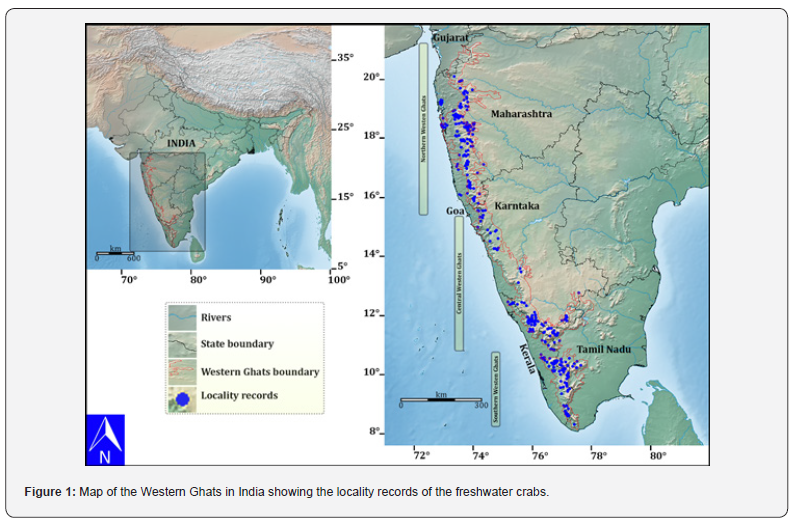
The Northern Western Ghats seems to be relatively well studied for the freshwater crabs as far as the genus-species proportion and locality records are concerned (Figure 1). The Central Western Ghats is poorly explored, which is evident from the smaller number of locality records (Figure 1). Sahyadriana is the most species-rich genus (10 species) in the Western Ghats followed by Ghatiana (8 species), Vanni (7 species), and Travancoriana (6 species). The remaining genera possess less than five species, with Inglethelphusa, Kani and Lamella are monotypic. All the known species of each genus are found in the Western Ghats except for Cylindrotelphusa and Oziotelphusa (Figure 2).
The first-ever species recorded from the Western Ghats is currently known as Barytelphusa cunicularis, which was originally described as Thelphusa cunicularis by J O Westwood in the work of W H Sykes during 1836 [18]. Thereafter, many crab species were described or reported from the Western Ghats [10,11,14-17,19- 57], especially during the last two decades that contribute nearly two-thirds of the currently known species (Figure 3).
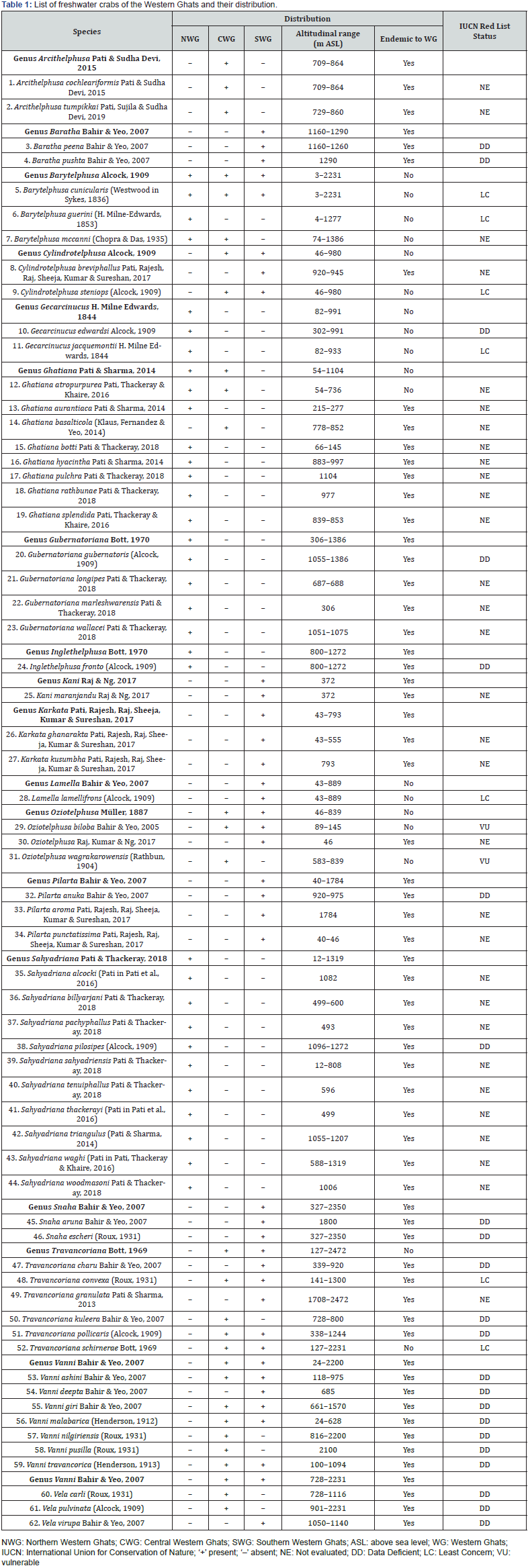
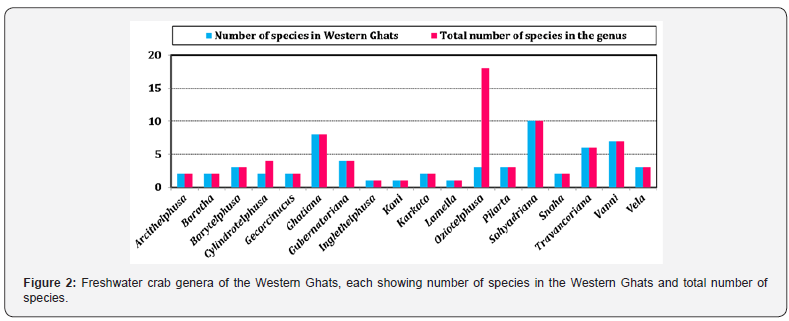
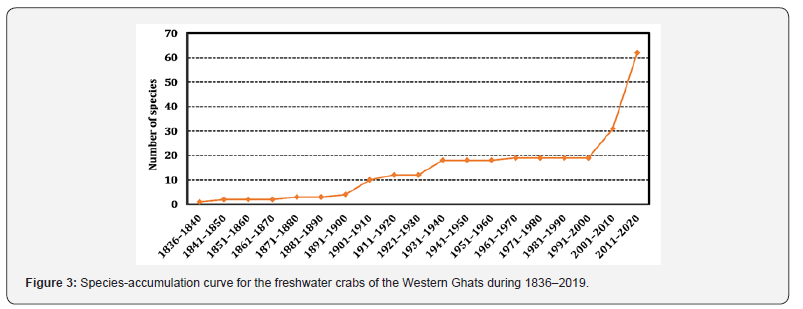
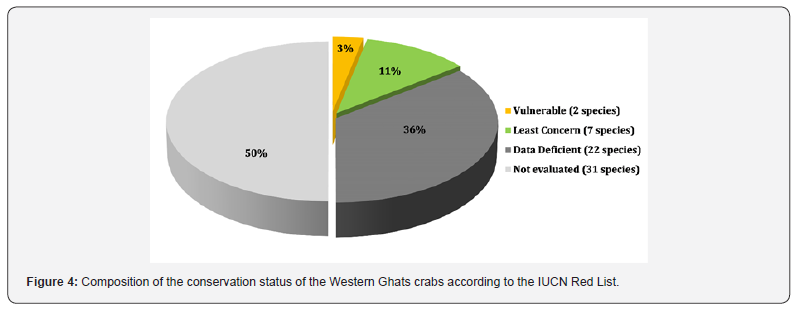
Distribution
The freshwater crabs of the Western Ghats are distributed all over the region from low-lying areas to high mountain peaks (3– 2472 m above sea level) (Table 1). As many as 10 genera (56%) and 21 species (34%) are found above the average elevation (1200 m) of the Western Ghats (Table 1). Seven species, viz. Barytelphusa cunicularis, Snaha escheri, Travancoriana granulata, Travancoriana schirnerae, Vanni nilgiriensis, Vanni pusilla, and Vela pulvinata, dwell above 2000 m elevation (Table 1). While most of these species are also found at relatively lower altitudes, Travancoriana granulata and Vanni pusilla are always restricted to highly elevated areas (1708–2472 m) [17, 31,35,36,39,53].
Among the freshwater crabs of the Western Ghats, 27 species in 6 genera are found in the Northern Western Ghats; 21 species in 8 genera in the Central Western Ghats; and 27 species in 12 genera in the Southern Western Ghats (Table 1). Barytelphusa cunicularis is the only species that widely occurs in the Western Ghats. On the other hand, most of the genera and species show a distinct pattern of distribution within the Western Ghats. Some of these genera (Gecarcinucus and Lamella) and species (Barytelphusa guerini and Oziotelphusa wagrakarowensis), however, are also found beyond the limit of the Western Ghats. Among the genera, Gecarcinucus, Gubernatoriana, Inglethelphusa, and Sahyadriana are distributed in the Northern Western Ghats only; Arcithelphusa in the Central Western Ghats only; and Baratha, Kani, Karkata, Lamella, Pilarta, and Snaha in the Southern Western Ghats only (Table 1). Among the species, Barytelphusa guerini and all the species of Ghatiana except for Ghatiana basalticola are distributed in the Northern Western Ghats only; Ghatiana basalticola, Oziotelphusa wagrakarowensis, Travancoriana kuleera, Vanni nilgiriensis, Vanni pusilla, Vela carli, and Vela pulvinata in the Central Western Ghats only; and Cylindrotelphusa breviphallus, Oziotelphusa ravi, Travancoriana charu, Travancoriana granulata, Vanni deepta, and Vela virupa in the Southern Western Ghats only (Table 1).
Endemism
Currently, nearly 63% genera (22/35 genera) and 86% species (107/125 species) of the freshwater crabs are endemic to India. Similarly, the Western Ghats crabs also show a high level of endemism, with 67% endemic genera (12/18 genera) and 82% endemic species (51/62 species) (Table 1). Nearly half of the endemic species of the Western Ghats (25/51 species) are highly restricted in distribution and so far, known only from their type locality [10,14–17,31,39,49,52,55].
Among the endemic crabs of the Western Ghats, Gubernatoriana (4 species), Inglethelphusa (1 species), and Sahyadriana (10 species) are restricted only to the Northern Western Ghats; Arcithelphusa (2 species) only to the Central Western Ghats; and Baratha (2 species), Kani (1 species), Karkata (2 species), Pilarta (3 species), and Snaha (2 species) only to the Southern Western Ghats (Table 1). In addition to the species of these endemic genera, as many as 18 endemic species of the Western Ghats are restricted only either to the Northern Western Ghats (e.g., Ghatiana aurantiaca, Ghatiana botti, Ghatiana hyacintha, Ghatiana pulchra, Ghatiana rathbunae, and Ghatiana splendida) or the Central Western Ghats (e.g., Ghatiana basalticola, Travancoriana kuleera, Vanni nilgiriensis, Vanni pusilla, Vela carli, and Vela pulvinata) or the Southern Western Ghats (e.g., Cylindrotelphusa breviphallus, Oziotelphusa ravi, Travancoriana charu, Travancoriana granulata, Vanni deepta, and Vela virupa) (Table 1).
Conservation
Conservation of freshwater crabs is essential because the proportion of freshwater crabs threatened with extinction is almost equal to that of reef-building corals and exceeds that of Odonata, freshwater fishes, reptiles, birds, and mammals [7]. The conservation of the Western Ghats crabs is nevertheless a challenge because the majority of the species (53/62 species, 86%) are either ‘Data Deficient’ (22 species, 36%) or not being evaluated for their conservation status (31 species, 50%) by the International Union for Conservation of Nature (IUCN) (Figure 4) (Table 1) [58]. While seven species (11%) were given the status of ‘Least Concern’, only two species (Oziotelphusa biloba and Oziotelphusa wagrakarowensis) had been categorized as ‘Vulnerable’ by the IUCN (Figure 4) (Table 1) [58].
Conclusion
Most of the freshwater crabs of the Western Ghats are known either from the type locality or from a few localities only. More surveys and explorations, especially from the Central- and Southern Western Ghats, are, therefore, needed to know their actual distributional range. With the rapid discovery rate, it is currently difficult to estimate their actual diversity. Many more taxa are yet to be described from this region, especially from the cryptic habitats. That is why a complete monograph on the Western Ghats crabs is a few decades away. Some genera (Arcithelphusa, Barytelphusa, Cylindrotelphusa, Travancoriana, and Vanni) need an urgent taxonomic revision. Moreover, a complete phylogeny of the freshwater crabs of the Western Ghats is likely to reveal many changes in their systematic position. Conservation of freshwater crabs of the Western Ghats is a matter of concern because most of the species lack important information like distributional range and population size, which are very crucial in the assessment of the conservation status. Most of the species in the Western Ghats, however, are endemic and can only tolerate a small range of environmental conditions. Those species are very likely to face severe threats. In these situations, the present review will aid as updated and baseline information in advancing our understanding of the freshwater crabs of the Western Ghats.
Acknowledgement
The first author is grateful to Dr Kailash Chandra, Director (Zoological Survey of India, Kolkata) for research facilities and constant encouragement. The first author gratefully acknowledges Dr Peter K.L. Ng and Dr Darren C.J. Yeo (National University of Singapore) for their continuous guidance on the subject. We would like to thank the following for their contributions on material, data, and time: Dr Santanu Mitra (Crustacea Division, Zoological Survey of India, Kolkata); Dr P.M. Sureshan (Western Ghat Regional Centre, Zoological Survey of India, Kozhikode); Dr A. Biju Kumar, Smrithy Raj and L. Rajesh (Department of Aquatic Biology and Fisheries, University of Kerala, Thiruvananthapuram, Kerala, India); Dr A.R. Sudha Devi and P.S. Sujila (Department of Zoology and Research Centre, Mary Matha Arts and Science College, Mananthavady, Kerala, India); S. Sheeja (Department of Zoology, Holy Cross College, Nagercoil, Tamil Nadu, India); T. Thackeray (a wildlife conservationist from Mumbai).
References
- Pascal JP (1988) Wet Evergreen Forests of the Western Ghats of India.Tropical Ecology45(2).
- Myers N, Mittermeier RA, Mittermeier CG, da Fonseca GAB, Kent J (2000) Biodiversity hotspots for conservation priorities. Nature 403: 853-858.
- Gunawardene NR, Dulip Daniels AE, Gunatilleke IAUN, Gunatilleke CVS, Karunakaran PV, et al. (2007) A brief overview of the Western Ghats—Sri Lanka biodiversity hotspot. Current Science 93(11): 1567-1572.
- Molur S, Smith KG, Daniel BA, Darwall WRT (2011) The status and distribution of freshwater biodiversity in the Western Ghats, India. In: IUCN Library System 1-116.
- Raghavan R, Dahanukar N, Philip S, Iyer P,Kumar B, et al. (2015)The conservation status of decapod crustaceans in the Western Ghats of India: an exceptional region of freshwater biodiversity. Aquatic Conservation: Marine and Freshwater Ecosystems25(2): 259-275.
- Yeo DCJ, Ng PKL, Cumberlidge N, Magalhaes C, Daniels SR, et al. (2008) Global diversity of crabs (Crustacea: Decapoda: Brachyura) in freshwater. Hydrobiologia 595(1): 275-286.
- Cumberlidge N, Ng PKL, Yeo DCJ, Magalhaes C, Campos MR, et al. (2009) Freshwater crabs and the biodiversity crisis: Importance, threats, status, and conservation challenges. Biological Conservation 142(8): 1665-1673.
- Klaus S, Schubart CD, Streit B, Pfenninger M (2010) When Indian crabs were not yet Asian - biogeographic evidence for Eocene proximity of India and Southeast Asia. BMC Evolutionary Biology 10: 287.
- WoRMS Editorial Board (2020) World Register of Marine Species.
- Pati SK, Thackeray T (2018) The freshwater crab genera GhatianaPati& Sharma, GubernatorianaBott, and InglethelphusaBott (Crustacea: Decapoda: Brachyura: Gecarcinucidae) revisited, with descriptions of a new genus and eleven new species. Zootaxa 4440(1): 1-73.
- Pati SK, Sujila PS, Sudha Devi AR (2019) Description of a new species of freshwater crab of the genus ArcithelphusaPati& Sudha Devi, 2015 (Decapoda: Brachyura: Gecarcinucidae) from the Western Ghats, Kerala, India. Zootaxa 4674(2): 203-214.
- Mitra S (2019) A new species of HimalayapotamonPretzmann, 1966 (Decapoda: Brachyura: Potamidae: Potaminae) from Western Himalaya, India. Journal of Environment & Sociobiology 16(2): 121-131.
- Pati SK, Vargila F (2019) A new species of the freshwater crab genus Oziotelphusa Müller, 1887 from Tamil Nadu, India (Crustacea, Decapoda, Brachyura, Gecarcinucidae). Spixiana 42(2): 203-216.
- Klaus S, Fernandez K, Yeo DCJ (2014) Phylogeny of the freshwater crabs of the Western Ghats (Brachyura, Gecarcinucidae). ZoologicaScripta 43(6): 651-660.
- Pati SK, Thackeray T, Khaire A (2016) Five new species of freshwater crabs of the genera GhatianaPati& Sharma, 2014, and GubernatorianaBott, 1970 (Crustacea, Decapoda, Brachyura: Gecarcinucidae Rathbun, 1904) from the Western Ghats, India. Zootaxa 4083(4): 569-586.
- Kumar AB, Raj S, Ng PKL (2017) Description of a new genus and new species of a fully arboreal crab (Decapoda: Brachyura: Gecarcinucidae) from the Western Ghats, India, with notes on the ecology of arboreal crabs. Journal of Crustacean Biology 37(2): 157-167.
- Pati SK, Sharma RM (2013) A new species of freshwater crab, Travancorianagranulata sp. (Brachyura: Gecarcinucidae) from the southern Western Ghats of India. Zoosystematics and Evolution 89(2): 275-281.
- Sykes WH (1836) Some account of the land crabs of the Dukhun by Lieut Col WH Sykes with a description of the species by JO Westwood. The Transactions of the Entomological Society of London 1(3): 181-184.
- Milne Edwards H (1844) Crustacé In: Jacquemont V (Ed), Voyage dans l’Inde, par Victor Jacquemont, pendant les années 1828 à 1832. Description des Collections. Tome Quatrième. Firmin Didot Frères, Paris, France,P. 1-9.
- Wood-Mason J (1871) Contribution to Indian Carcinology—On Indian and Malayan Telphusidae, Part-I. Journal of the Asiatic Society of Bengal40(2): 189-200.
- Wood-Mason J (1871) Contribution to Indian Carcinology—On Indian and Malayan Telphusidae, Part-I. Journal of the Asiatic Society of Bengal40(3): 201-207.
- Henderson JR (1893) A Contribution to Indian Carcinology. The Transaction of the Linnean Society of London 5(10): 325-458.
- Ortmann AE (1897) Carcinologische Studien. Zoologische Jahrbücher Abteilung für Systematik, Geographie und Biologie der Thiere 10(3): 258-372.
- De Man JG (1898) Viaggio di Leonardo Fea in Birmanica e regioni vicine LXXXI—Note sur quelques espèces des genres Parathelphusa HME et Potamon Sav, recueillies par M Leonardo Fea pendant son voyage en Birmanie. Annali del Museo civico di Storia naturale di Genova 19(39): 384-440.
- Rathbun MJ (1905) Les crabes d’eau douce (Potamonidae). Nouvelles Archives du Muséum d’Histoire Naturelle, Paris (4)7: 159-321.
- Rathbun MJ (1906) Les crabes d’eau douce (Potamonidae). Nouvelles Archives du Muséum d’Histoire Naturelle, Paris (4) 8: 33-122.
- Alcock A (1909) Diagnoses of new species and varieties of freshwater crabs Nos. 4. Records of the Indian Museum 3(4):375-381.
- Alcock A (1910) Catalogue of the Indian decapod Crustacea in the collection of the Indian Museum. Part I. Brachyura. Fasciculus II. The Indian fresh-water crabs—Potamonidae. Indian Museum, Calcutta, India,Pp. 1-135.
- Henderson JR (1912) Description of a new species of freshwater crab from Southern India. Records of the Indian Museum 7(2): 111-112.
- Henderson JR (1913) A new variety of freshwater crab from Travancore. Records of the Indian Museum 9(2): 47-49.
- Roux J (1931) CrustacésDécapodesd’eaudouce de l’Indemé Revue Suisse de Zoologie 38(2): 31-62.
- McCann C (1937) Notes on the common land crab Paratelphusa (Barytelphusa) guerini of Salsette Island. Journal of the Bombay Natural History Society 39(3): 531-542.
- Ramakrishna G (1951) Notes on some Indian Potamonid crabs (Crustacea: Decapoda). Records of the Indian Museum 48(2): 89-92.
- Bott R (1969) FlußkrabbenausAsien und ihreKlassifikation (Crustacea, Decapoda). SenckenbergianaBiologica 50(5/6): 359-366.
- Bott R (1970) Die Süßwasserkrabben von Europa, Asien, Australien und ihreStammesgeschichte. Eine Revision der Potamoidea und Parathelphusoidea (Crustacea, Decapoda). Abhandlungen der SenckenbergischenNaturforschenden Gesellschaft 526: 1-338.
- Bott R (1970) Betrachtungenüber die Entwicklungsgeschichte und Verbreitung der Süsswasser-Krabbennach der Sammlung des Naturhistorischen Museums in Genf/Schweiz. Revue Suisse de Zoologie 77(2): 327-344.
- Srivastava OP (2005) Freshwater crabs (potamonids) in the collection of the Southern Regional Station, Zoological Survey of India, Chennai. Records of the Zoological Survey of India 104(1-2): 115-122.
- Srivastava OP, Krishnan S (2006) Crustacea:Decapoda: Gecarcinucidae (Crabs). In: The Director (Ed), Fauna Biligiri Rangaswamy Temple Wildlife Sanctuary (Karnataka), Conservation Area Series 27. Zoological Survey of India, Kolkata, India, Pp. 17-20.
- Srivastava OP (2007) Crustacea: Brachyura: Crabs. In: The Director (Ed), Fauna Bannerghatta National Park, Conservation Area Series 33. Zoological Survey of India, Kolkata, India, Pp. 33-37.
- Ghatak SS, Ghosh SK (2008) Crustacea: Decapoda: Palaemonidae: Gecarcinucidae. In: The Director (Ed.), Fauna Goa, State Fauna Series 16. Zoological Survey of India, Kolkata, India, Pp. 165-172.
- Pati SK, Sharma RM (2011) New record of a freshwater crab Vannitravancoricafrom Uttar Kannada district of Karnataka. Bionotes 13(4): 152.
- Pati SK, Sharma RM (2012) Freshwater crabs of some protected areas and wetlands, Maharashtra. Bionotes 14(4): 126-127.
- Thigale D (2012) Study of freshwater crabs and prawns (Arthropoda: Crustacea: Decapoda) of Krishna River at Sangli and Wai, Maharashtra. M.Sc. Dissertation, University of Pune, Pune, India.
- Srivastava OP (2013) Crustacea: Decapoda: Gecarcinucidae (Freshwater and Land Crabs). In: The Director (Ed.) Fauna Karnataka, State Fauna Series 21. Zoological Survey of India, Kolkata, India Pp. 73-78.
- Pati SK, Sharma RM (2014) Freshwater crabs (Crustacea: Decapoda: Brachyura: Gecarcinucidae) in the collection of the Western Regional Centre, Pune. Records of the Zoological Survey of India, Occasional Paper 363: 1-44.
- Pati SK, Sharma RM (2014) Freshwater crabs (Crustacea: Decapoda: Brachyura: Gecarcinucidae). In: The Director (Ed.), Fauna Chandoli National Park. Conservation Area Series 51. Zoological Survey of India, Kolkata, India,Pp. 59-64.
- Pati SK, Sharma RM (2014) Freshwater crabs (Crustacea: Decapoda: Brachyura: Gecarcinucidae). In: The Director (Ed.), Fauna Radhanagari Wildlife Sanctuary, Conservation Area Series 52. Zoological Survey of India, Kolkata, India, Pp. 115-120.
- Pati SK, Sharma RM (2014) Description of Ghatiana, a new genus of freshwater crab, with two new species and a new species of Gubernatoriana(Crustacea: Decapoda: Brachyura: Gecarcinucidae) from the Western Ghat Mountains, India. Journal of Natural History 48(21-22): 1279-1298.
- Pati SK, Sharma RM, Sureshan PM (2014) Freshwater crabs (Crustacea: Decapoda: Brachyura: Gecarcinucidae) in the collection of Western Ghat Regional Centre, Zoological Survey of India, Kozhikode. Records of the Zoological Survey of India 114(4): 651-668.
- Pati SK, Sudha Devi AR (2015) Description of a new genus and new species of freshwater crab (Brachyura: Gecarcinucidae) from the Western Ghats, Kerala, India. Zoological Studies 54: 35.
- Raj S, Kumar AB, Ng PKL (2017) A new species of freshwater crab of the genus Oziotelphusa Müller, 1887 (Crustacea: Decapoda: Brachyura: Gecarcinucidae) from Tamil Nadu, southern India. Zootaxa 4363(2): 225-236.
- Rajesh L, Raj S, Pati SK, Kumar AB (2017) The freshwater crabs (Decapoda: Brachyura) of Kerala, India. Journal of Aquatic Biology & Fisheries 5:132-153.
- Pati SK, Sharma RM (2017) Freshwater crabs (Brachyura: Gecarcinucidae). In: The Director (Ed), Fauna Phansad Wildlife Sanctuary, Maharashtra, Conservation Area Series 59. Zoological Survey of India, Kolkata, India, Pp. 9-14.
- Pati SK, Rajesh L, Raj S, Sheeja VU, Kumar AB, et al. (2017) Karkata, a new genus of gecarcinucid freshwater crab with two new species, and four new species of Pilarta Bahir and Yeo, 2007 and CylindrotelphusaAlcock, 1909 (Decapoda: Brachyura) from Kerala, India. Journal of Natural History 51(23-24): 1295-1330.
- Pati SK, Sujila PS, Sudha Devi AR (2019) New records of two species of freshwater crabs (Decapoda: Gecarcinucidae) from Kerala, India, with notes on their distribution. Nauplius 27: e2019006.
- Pati SK, Sharma RM, Sureshan PM (2019) Freshwater crabs (Decapoda: Brachyura: Gecarcinucidae). In: The Director (Ed), Fauna Malabar Wildlife Sanctuary, Kozhikode, Kerala, Conservation Area Series 62. Zoological Survey of India, Kolkata, India, Pp. 11-15.
- IUCN (2020) The IUCN Red List of Threatened Species.
- Bahir MM, Yeo DCJ (2007) The gecarcinucid freshwater crabs of southern India (Crustacea: Decapoda: Brachyura). Raffles Bulletin of Zoology 16: 309-354






























